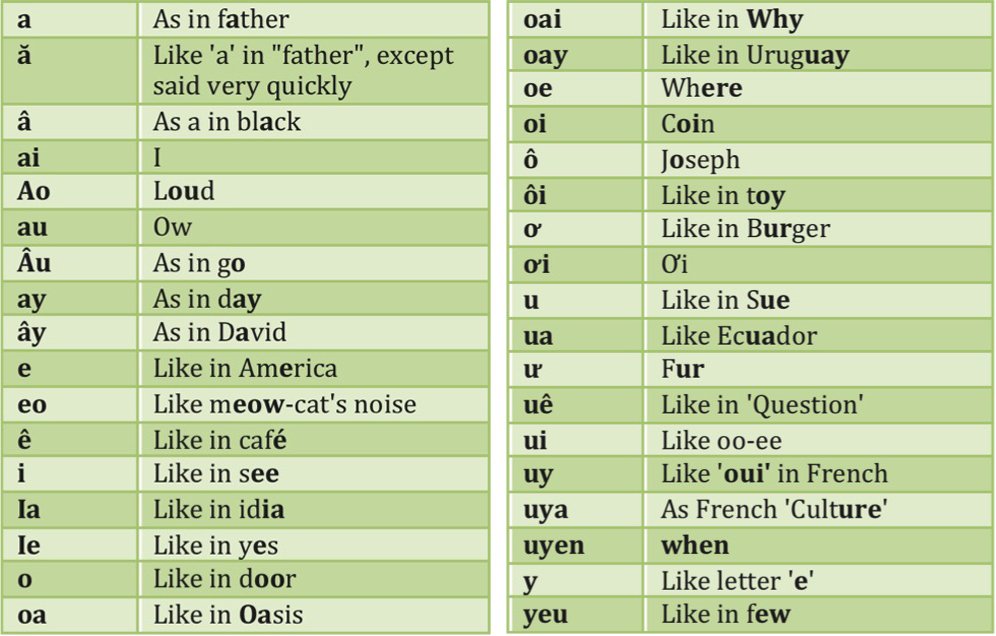Vietnamese Crash Course

Today I am going to do a Vietnamese Crash Course for those who are learning or want to learn Vietnamese.
As redundant as it may sound, Vietnamese is the official language in Vietnam. But for a very long time Vietnam didn’t really have its own language. For so long it was object of constant foreign intervention. Therefore, Vietnamese has borrowings from Chinese, French and also English. Vietnamese is a difficult language, especially because it differs between regions.
Like other Southeast Asian languages, Vietnamese has a comparatively large number of vowels.

Some consonant sounds are written with only one letter like “p”, other consonant sounds are written with a digraph like “ph”, and others are written with more than one letter or digraph. Vietnamese has no use for the letters F, J, W and Z. Also, not all dialects of Vietnamese have the same consonant in a given word (although all dialects use the same spelling in the written language).
So in Vietnamese, every syllable is a separate word, this is why Vietnam is sometimes written as Viet Nam!
Tones
Vietnamese is a tonal language, with 6 tones in total, which means that one syllable can have at least 6 different meanings. Be careful with the tones! You’ll probably end up calling someone’s mother a horse or a grave at some point. Tones differ in length, melody, pitch height and phonation. The tone is indicated by diacritics written above or below the vowel.

Grammar
Similarly to languages in Southeast Asia, there is no real number and gender for nouns in Vietnamese and verb tenses generally don’t exist.
Useful Phrases
Basic
- xin chào = Hello
- Khỏe không? = How are you?
- Khoẻ, cảm ơn = Fine, thank you!
- Tôi tên là… = My name is…
- Làm ơn = Please
- Cảm ơn = Thank you
- Không sao đâu = You are welcome
- Vâng = Yes
- Không = No
- Xin lỗi = I’m sorry
- Tạm biệt = Goodbye
Lost in Translation
- Biết nói tiếng Anh không? = Do you speak English?
- Tôi không biết nói tiếng Việt [giỏi lắm] = I can’t speak Vietnamese [well]
- Có ai đây biết nói tiếng Anh không? = Is there someone here who speaks English?
- Tôi không hiểu = I don’t understand
Emergency
- Công an!/Cảnh sát! = Police!
- Việc này khẩn cấp = It’s an emergency
- Tôi bị lạc = I’m lost
- Tôi bị ốm = I’m sick
- Tôi cần một bác sĩ = I need a doctor
- Nhà vệ sinh/wc ở đâu? = Where’s the toilet?
- Cứu (tôi) với! = Help!
Transportation
- Một vé đến … là bao nhiêu? = How much is a ticket to …?
- Xin cho tôi một vé đến … = One ticket to …, please.
- Tàu/xe này đi đâu? = Where does this train/bus go?
- Tàu/xe đi đến …ở đâu? = Where is the train/bus to …?
- Tàu/xe này có ngừng tại…không? = Does this train/bus stop in…?
- Tàu/xe đi…chạy lúc nào? = When does the train/bus for…leave?
- Khi nào tàu/xe này xẽ đến…? = When will this train/bus arrive in…?
- Tắc xi! = Taxi!
- Làm ơn đưa/chở tôi đến… = Take me to…, please.
- Mất bao nhiêu tiền để đến…? = How much does it cost to get to…?
Money
- Có nhận thẻ tín dụng không? = Do you accept credit cards?
- Tôi có thể đi đổi tiền ở đâu? = Where can I get money changed?
- Máy rút tiền (ATM) ở đâu? = Where is an automatic teller machine (ATM)?
Food
- Cho tôi một bàn cho một/hai người = A table for one person/two people, please.
- Cho tôi xem menu? = Can I look at the menu, please?
- Tôi ăn chay. = I’m a vegetarian.
- Tôi không ăn thịt heo (South) / lợn (North) = I don’t eat pork.
- Tôi không ăn thịt bò. = I don’t eat beef.
- Tôi chỉ ăn thức ăn kosher thôi. = I eat only kosher food.
- Cho tôi xin một chaicà phê / nước trà / nước / rượu vang / bia? = May I have a bottle of coffee / tea / water / wine / beer ?
- Cho tôi xin một ly (South) / cố (North) …? = May I have a glass of …?
- Cho tôi xin một ly (South) / cố (North) …? = May I have a cup of …?
Shopping
- Có size của tôi không? = Do you have this in my size?
- Bao nhiêu (tiền)? = How much (money) is this?
- Đắt quá. = That’s too expensive.
Tips
Seems like these tips might have been said many times before, but they are so true and useful!
- First of all, look for language classes. Either in a one-on-one class or in a group class, you can learn about the differences in tones and the Vietnamese grammar. Don’t be afraid to ask questions when you don’t understand.
- Also, practice makes perfect! For some people, learning a new language might come easier than for others, but no one can be fluent without practicing. You can look for a language partner. Go out and make friends!
- Last, but not least, don’t be afraid to make mistakes! Locals will appreciate that you are making an effort on learning their language and you can also learn from your mistakes.
Learn more and apply now!







